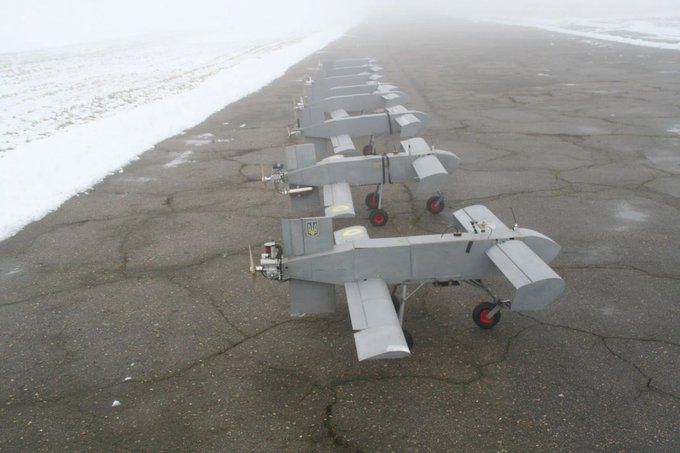The Ukrainian military received the first batch of new AQ400 Scythe UAVs, loitering munitions meant to both hit land targets and bait and overload air defense systems.
The latter is to force Russia to use up its missile stocks, clearing the way for a second more significant wave of Ukrainian strikes, according to Russian defense experts. Pictures and videos of the simple and elementarily designed drones went around on several Telegram groups and Ukraine-affiliated media.
The drones’ admittedly artisanal, largely rudimentary, basic design and simple technology have been presented as their hallmark. This is in harmony with Ukraine’s particular need for a large stockpile of weapons, technological advancement notwithstanding, especially given the fact that it is nearly wholly dependent on Western donations for both small and big platforms and ammunition.
Generally, it is consistent with the trend of using simple, primary, technologically less complex yet effective weapons. This involves drones with cameras for battlefield surveillance, artillery fire correction, civilian UAVs strapped with explosives for kamikaze roles, ‘bombing roles,’ or even simple artillery pieces and mines for anti-tank defenses in significant World War 1-style attritional warfare.
New Ukrainian UAV
According to Ukraine-affiliated news portal Defense Blog, AQ400 Scythe has a range of up to 750 kilometers and “is designed to be launched from short runways or catapults.” It can carry a payload of up to 32 kilograms, with the ability to increase to 70 kg, but that reduces the flight range.
The UAV has an internal combustion engine fitted at the rear that drives a pusher-propeller with a tandem-wing configuration. Videos on X (formerly Twitter) showed the UAV flying overhead, with either the tricycle landing gear still attached or the wheels dropping off, as shown in another clip.
It is unclear if the UAV has both features – with and without the landing gear – or if one of the videos did not capture the part where the wheels were released.

The UAV has been developed by Terminal Autonomy, formerly known as One Way Aerospace, which Defense Blog said was announcing the “battle deployment” of the system.
It suggests the drone has been extensively tested and is ready for combat, with possibly a commercial motive behind the announcement that seeks Western investment in Ukraine’s private and state-run defense industrial base.
The report quoted a statement from the company that announced the development and fielding of the drone, which has been marked by an initial production capacity of 100 units and ambitious plans to scale up to 500 units monthly. It heralds a “significant leap in strategic warfare capabilities for the Ukrainian Armed Forces.”
Russian Defense Expert Warns About The Drone
The AQ400 Scythe’s hallmark features include “rapid assembly, mass production capabilities, and cost-effectiveness, marking it as a pivotal asset in modern warfare.”
These features have also made the Russian camp sit up and notice, who have expressed caution and urged not to underestimate the weapon, acknowledging the credible threat it poses to its surface-to-air missile (SAM) batteries and land targets.
Telegram channel ‘Rusengineer’ said, referring to the Ukrainian defense industry and Russian military bloggers (mil-bloggers) for dismissing the drone: “The locals rolled out this product, and as expected, they began to ridicule it in our public pages for its primitiveness and unsightly appearance.
“What is, that is, after the aerodynamically polished Beaver, this drone looks as if it was made not just by the crooked hands of the children of Africa, but they also multiplied on it in the process.”
The post said he “would not rush to ridicule the enemy (since) strategically they have plenty of examples of quite decent technology so that a possible explanation may be quite logical – this primitiveness is not due to a low level of design culture but from the goal of maximizing cost reduction.”
🇺🇦ウクライナの新型自爆ドローン「AQ400 Scythe」。価格は1万5000ドル(213万円〜)から。32kgの爆発物を運ぶことが出来る。更に射程は750km〜950kと、射程が長い。https://t.co/HlsrTw0D1h pic.twitter.com/v0tIHTBK4v
— 大規模攻撃/daikibokougeki (@daikibokougeki) December 18, 2023
While it is “clear” that such devices “have no chance against (Russian) air defense,” it raises a question about their intended target.
“Their main goal is the fight against air defense as decoys. Lure expensive missiles at them, open-air defense positions and discharge the installations with massive use, and then launch a second wave of more effective attack weapons. Actually, as we do, our false goals also look rather awkward, so everything fits together,” the post said.
The line recognized how Russia itself employed this tactic of overwhelming and baiting Ukraine’s Western air defenses, which wasn’t always successful.
- The author can be reached at satamp@gmail.com
- Follow EurAsian Times on Google News